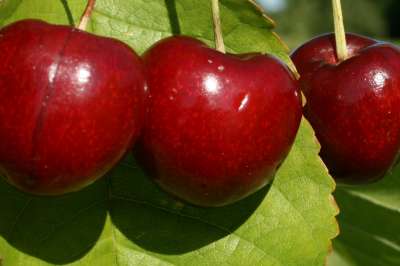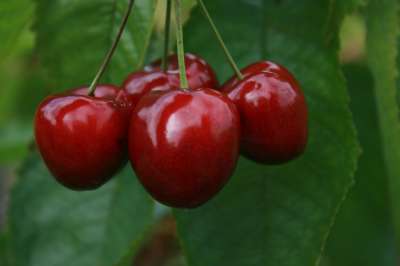Your basket is currently empty!
Buy healthy new cherry trees here!
Cherry Blackfly – cherry leaf curl
Is by far the commonest problem you may encounter on garden cherry trees, and to be honest you are almost bound to be troubled by these invaders unless you spray as a preventative measure. The insects collect mostly on the new growths so that the shoot tips become completely curled and infested; this can stop the new shoots from growing completely. These insects are quite easy to deal with. Provado is a good systemic insecticide that kills on contact but also works from within the tree sap which is important as a lot of the insects may be protected inside the curled leaves. As a general rule apply the first application in early May and again about 6 weeks later.
If your cherry tree already has severely curled and infested growth it might be best to simply snip them off with sharp secateurs and destroy the growths, thus eliminating the blackfly as well. New growths will form from just below where you cut. A winter wash applied whilst the tree is dormant will help kill off any overwintering populations and help promote clean growth in the Spring. Biological controls are available also if you prefer not to use chemicals, but they do take time to adjust the balance which if you have an established prolific blackfly population may not be practical.
Bacterial canker
The symptoms of bacterial canker are sunken patches on the main trunk and branches which spreads until it completely encircles the stem which may become swollen and patchy. Weeping patches of gum from the main stems sometimes signify canker but can also be symptomatic of more general stress. The best cause of action for canker is to remove completely stems that infected but this is of course not viable if the disease is present on the main stem. Chemicals that were effective against canker have mostly been withdrawn but if you do have Bordeaux mixture or a copper based fungicide in your store then these can be applied.
Canker is a widespread and common disease and can be more prevalent in damp or humid area’s and may be more troublesome after a wet summer. As with all trees, the better looked after and stronger the trees are the more able they will be to withstand canker.
Here’s a nice healthy cherry tree orchard!

Fruit drop in cherries
This is a common disorder with cherry trees and despite a lot of research work having been done on the subject the causes are poorly understood and probably varied. But there are several practices you can employ to ensure your cherry tree carries it’s crop to maturity.
Ensuring a predictable and regular water supply is the most important. It would seem that dryness at the roots can have a profound effect on the trees ability to carry it’s crop to maturity. But to suddenly provide buckets of water after a drought can do as much harm as good and may also cause fruit splitting. It is best to be vigilant from the moment the fruits set and provide additional watering at all times unless there has been heavy rain.
Heavy rain itself may damage fruit clusters and cause shedding. In Spring, 3-4 weeks after fruit set, inspect your cherry trees and if you feel the weight of the crop is too great you can thin the clusters or remove some entirely. This will ensure your tree has enough strength to carry them all to maturity and will also increase the size of the fruit.
And lastly poor light levels have been linked to cherry trees shedding fruit. Providing a pale background such as white sheeting beneath the tree, or growing them against a light background or wall, has been proven to help.
Fruit splitting
As referred to above is caused by irregularities in the water supply and may be especially troublesome if you are growing trees in containers. Make sure additional irrigation is regular and predictable. Heavy rain will cause splitting so be prepared to provide some cover if it is forecast during the fruits formative period. Some varieties have natural resistance to fruit splitting.
Additional feeding
Should be applied in February or March before blossom time. Growmore or Bonemeal are both very good. Rake it gently into the soil around the tree, covering an area roughly the same as the rootball. You can water it in gently if the soil is dry but make sure you use a rose to prevent it being leached away.
The Acid Cherry
Cooking cherry trees are actually quite different to sweet cherries. The appearance is a little different, the leaves are smaller and darker, not so shiny and the wood has a darker appearance too. The trees are a little less vigorous, especially in the early years. The acid cherry is a hardier proposition, more suitable to the North than sweet dessert varieties and that is why it is virtually the only fruit tree that will tolerate a North wall. You will need 6-8’ in height, and the same in width, to fan train a cooking cherry. All of the main varieties of cooking cherry are self fertile so there are no pollination issues. They also tend to be good pollinating partners to other varieties. Although sometimes gardeners dismiss the idea of planting a cherry that you have to cook and sweeten to eat, those who do have a mature tree would never be without it. The fruits are surprisingly versatile and it’s not the kind of thing you can ever buy in the shops. Just think of all the jams and pies you can make, not to mention juicing, freezing, bottling and drying – the acid cherry excels at all those things, much more so than the sweet cherry which is primarily for eating fresh.
Varieties

Morello remains the first choice and is the best variety for all general planting. The range of varieties in this group is relatively small. Kelleris is another that you might encounter and Nabella is a newer type with some very good qualities. All are self fertile and to be honest quite difficult to tell apart. Pruning the cooking cherry tree is different to the sweet varieties. Pruning acid cherries is a little different to sweet cherries as the fruit is carried exclusively on 1 year old. The aim of pruning should be to encourage a plentiful supply of new growth to fruit next year. On older trees make sure you remove a proportion of older growth to encourage strong new fruiting growths for the next year.
So there we have it – a guide to getting the best from our luscious cherry trees. As well as outlining the pitfalls and problems I hope it has encouraged you also to grow these, the most delicious of top fruits and that being armed with the necessary knowledge has made you confident enough to plant these trees in your garden or orchard. The rewards make a little effort more than worthwhile, not just in the personal satisfaction of harvesting your own fresh picked cherries, but also the savings that can be made on the very high price of shop-bought cherries.
I will endeavour to update this article regularly and, as always, if you have any comments or questions contact me.






